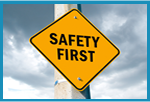Victim Media Advocacy:
How to Facilitate Sensitive and Respectful Treatment of Crime Victims
The Role of Victim Service Providers
Victim service providers have two important roles when dealing with the media on behalf of crime victims as—
- Facilitators who often serve as a liaison between victims and the media and, for victims who choose to speak to the media, help them prepare for all media interactions and interviews.
- Public awareness professionals who, on behalf of their organizations and the victims they serve, promote victim outreach and public education through the news media and other venues.
These two roles are not mutually exclusive and often overlap. Becoming a reliable, trusted source to the media involves both victim/media facilitation and strong media relations to promote victims’ rights and services. Individual victims put a real face to crime and statistics. By publicly sharing their experiences as victims, they fulfill the media’s need for relevant news and help people better understand the devastating impact of crime on victims and communities.
This section of the guide addresses the role of advocate as facilitator. Section 2 addresses “How to Build Positive Relations With the News Media.”
There are often many professionals associated with a criminal case, including law enforcement officials, prosecutors, court personnel, community and institutional corrections officials, attorneys general, and public information officers or victim/witness staff within each agency. Case coordination can help ensure that the integrity of a case is not negatively affected by dealings with the media.
 Case coordination can also build consensus regarding if and how justice professionals and victims deal with the media. The goal is not to prevent media coverage but rather to facilitate it in a way that protects the integrity of the case and any privacy wishes of the victim while meeting the media’s need for information.
Case coordination can also build consensus regarding if and how justice professionals and victims deal with the media. The goal is not to prevent media coverage but rather to facilitate it in a way that protects the integrity of the case and any privacy wishes of the victim while meeting the media’s need for information.
Working closely with allied professionals involved in a case, victim service providers can—
- Determine in advance any allied professionals who are publicly representing their agencies in a specific case and develop a list with contact information (names, titles, telephone numbers, and e-mail addresses).
- Determine the victim’s clear wishes about dealing with the media and share their wishes with others involved in the case, as well as the media.
- Solicit input from each about if, when, and how media interviews can be conducted.
- Coordinate any release of specific information to the media related to the facts of the case or the crime victim/witness.
- Obtain consensus among key players to refrain from speaking about the case in public venues where such conversations can be overheard.
- Discuss any issues related to pretrial publicity (which can result in a change of venue) or preparole hearing publicity (which can affect the process and outcomes of such hearings).
- Coordinate any victim privacy protection guidelines with justice officials (such as prosecutors, court officials, or parole board members), especially in cases in which cameras are allowed in the courtroom or parole board hearing room.
- In cases involving justice system proceedings where victims do not want to speak to the media, determine in advance a private room in the courthouse or correctional agency for the victims and alternative routes for the victim to enter and exit without being confronted by the media.
- To the contrary, if case officials and victims will be speaking to the media, determine a location that addresses the victim’s comfort needs, as well as the needs of the media (i.e., light, sound, and electrical outlets).

Victim service providers can also ensure that victims are involved in efforts related to case coordination and that any relevant information is provided to them.
 It is always the victim’s choice whether or not to conduct an interview. There may be times when it is not advisable to give interviews, such as during a trial, or when it is against court rules to give interviews, such as when a judge issues a “gag order” during a trial.
It is always the victim’s choice whether or not to conduct an interview. There may be times when it is not advisable to give interviews, such as during a trial, or when it is against court rules to give interviews, such as when a judge issues a “gag order” during a trial.
It is also important to recognize that the trauma of victimization—especially in the hours, days, and weeks following a crime—may preclude a victim from conducting effective interviews. Since victims at this point may be unaware of the intricacies of the news media and may not understand the potential implications of agreeing to interviews, the role of the victim advocate is critical in helping victims examine their choices related to talking to the media, as well as the consequences of such choices. Advocates can help victims fully explore any concerns related to—

- The victim’s personal safety. By publicly speaking out, there may be risks associated with the alleged or convicted defendant or his/her cohorts, based on past behaviors or current threats.
- Privacy and confidentiality. Once a victim is identified by name, it becomes part of the public record. This is an important choice that, once made, cannot be rescinded.
- Potential trauma and stress. Media interviews can be stressful to victims. Talking to journalists can ease the trauma by validating the victim’s experiences or it can add to problems by asking the person to relive a traumatic experience. While careful preparation can ease some potential stress, victims should be aware of how the trauma of victimization can be either increased or decreased by speaking to the media.
 The impact on a criminal case. Anything a victim says in the media can be used in a criminal investigation, court, parole board hearings, or appeals process. This is why case coordination (see above) is essential to help victims understand any possible consequences of speaking publicly about an ongoing case (e.g., pretrial publicity can result in a change of venue).
The impact on a criminal case. Anything a victim says in the media can be used in a criminal investigation, court, parole board hearings, or appeals process. This is why case coordination (see above) is essential to help victims understand any possible consequences of speaking publicly about an ongoing case (e.g., pretrial publicity can result in a change of venue).- Providing “balance” to news coverage. Some victims feel compelled to speak to the media after reading, seeing, or hearing news stories that present the perspective of the alleged or convicted defendant. Giving “their side of the story” is often a key factor in a victim’s decision whether or not to speak to the media.
- Increasing awareness about the impact of crime. Any time victims speak publicly about their experiences, it helps humanize crime victims and survivors as real people who are hurt by crime. This can promote greater understanding of the impact of crime on victims and communities and increase empathy within the community.




